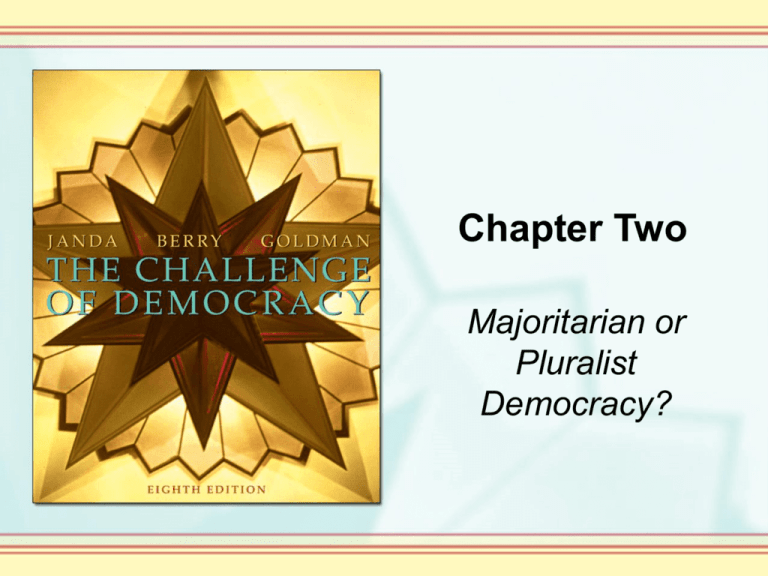
Chapter Two
Majoritarian or
Pluralist
Democracy?
The Theory of Democratic Government
• Theories of a democratic government
include consideration of:
• Autocracy: power to govern is concentrated
in the hands of one individual.
• Oligarchy: power is concentrated in the
hands of a few people.
• Democracy: in theory, the people rule, either
directly or indirectly.
Copyright © Houghton Mifflin Company. All rights reserved.
2-2
The Theory of Democratic Government (Cont’d)
• The Meaning and Symbolism of
Democracy
• The first major school of thought about what
constitutes democracy believes that
democracy is a form of government that
emphasizes the procedures that enable the
people to govern or how decisions are made.
Copyright © Houghton Mifflin Company. All rights reserved.
2-3
The Theory of Democratic Government (Cont’d)
• The Meaning and Symbolism of
Democracy
• The second major school of thought about
what constitutes democracy see democracy in
the substance of government policies, in
freedom of religion and the provision for
human needs or what government does.
Copyright © Houghton Mifflin Company. All rights reserved.
2-4
The Theory of Democratic Government (Cont’d)
• The Procedural View of Democracy
• Procedural democratic theory establishes
principles that describe how government
should make decisions. The principles
address three questions:
• Who should participate in decision-making?
• How much should each participant’s vote count?
• How many votes are needed to reach a decision?
Copyright © Houghton Mifflin Company. All rights reserved.
2-5
The Theory of Democratic Government (Cont’d)
• Universal participation: everyone in a
democratic society should participate in
governmental decision-making.
• The principle of political equality
establishes an equality in political
decision-making providing for one vote per
person, with all votes counted equally.
Copyright © Houghton Mifflin Company. All rights reserved.
2-6
The Theory of Democratic Government (Cont’d)
• The decision of a group must reflect the
preference of more than half of those
participating; a simple majority, known as
majority rule.
Copyright © Houghton Mifflin Company. All rights reserved.
2-7
A Complication: Direct Versus Indirect
Democracy
• Societies can meet these principles with a
direct or participatory democracy, which
is a system of government where rankand-file citizens rule themselves rather
than electing representatives to govern on
their behalf.
Copyright © Houghton Mifflin Company. All rights reserved.
2-8
A Complication: Direct Versus Indirect
Democracy (Cont’d)
• The framers of the Constitution were
convinced that participatory democracy on
the national level was undesirable and
instead instituted representative
democracy, a system of government
where citizens elect public officials to
govern on their behalf.
Copyright © Houghton Mifflin Company. All rights reserved.
2-9
A Complication: Direct Versus Indirect
Democracy (Cont’d)
• Responsiveness: Idea that the general
contours of public opinion would be
followed in formulating complex pieces of
legislation.
• This accounts for the possibility that elected
representatives might not make the decisions
people would have made had they gathered
for the same purpose
Copyright © Houghton Mifflin Company. All rights reserved.
2-10
The Substantive View of Democracy
• Democracy is embodied in the substance
of government policies rather than in the
policymaking procedure. The criterion for
substantive democracy states that
government policies should guarantee civil
liberties and civil rights.
Copyright © Houghton Mifflin Company. All rights reserved.
2-11
Procedural Democracy Versus Substantive
Democracy
• The problem with the substantive view of
democracy is that it does not provide clear,
precise criteria that allow a determination
of whether or not government is
democratic.
Copyright © Houghton Mifflin Company. All rights reserved.
2-12
Procedural Democracy Versus Substantive
Democracy (Cont’d)
• The procedural viewpoint, while presenting
specific criteria for democratic
government, can produce undesirable
social policies because of those criteria,
such as those that prey on minorities.
Copyright © Houghton Mifflin Company. All rights reserved.
2-13
Institutional Models of Democracy
• The majoritarian model of democracy is
the classical theory of democracy in which
government by the people is interpreted as
government by the majority of the people.
Copyright © Houghton Mifflin Company. All rights reserved.
2-14
Institutional Models of Democracy (Cont’d)
• The pluralist model of democracy is an
interpretation of democracy in which
government by the people is taken to
mean government by people operating
through competing interest groups.
Copyright © Houghton Mifflin Company. All rights reserved.
2-15
Institutional Models of Democracy (Cont’d)
• A comparison of the majoritarian and
pluralist models reveals:
• Majoritarian model:
• Conclusive elections
• Centralized structure of government
• Cohesive political parties with well-defined
programs
Copyright © Houghton Mifflin Company. All rights reserved.
2-16
Institutional Models of Democracy (Cont’d)
• Pluralist model:
• Does not demand much knowledge from
citizens in general but requires specialized
knowledge of groups of citizens
• Limits majority action - allows minorities to
rule
Copyright © Houghton Mifflin Company. All rights reserved.
2-17
Institutional Models of Democracy (Cont’d)
• An undemocratic model, elite theory, is
the view that a small group of people
actually makes most of the important
government decisions.
Copyright © Houghton Mifflin Company. All rights reserved.
2-18
Democracies and Globalization
• Democratization is a process of transition
as a country attempts to move from an
authoritarian form of government to a
democratic one.
Copyright © Houghton Mifflin Company. All rights reserved.
2-19




